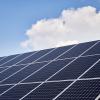
The Institute for Applied Systems Analysis (IIASA) recently partnered with a local photovoltaic (PV) supplier to implement a 220 kWp system using nearly 500 PV panels. With construction now finished, the investment anticipates yielding financial returns over the next decade. This initiative not only presents a substantial opportunity to reduce the Institute’s greenhouse gas footprint but also provides economical energy savings potential.
The foundation for this project was established through the development of a PV concept in early 2022, and after an external evaluation the IIASA management team made the strategic decision to invest in this important area.
“Due to our Institute’s leading status in the field of scientific sustainability and our central position as a global problem solver for environmental issues, we also wanted to strengthen and expand this role internally. Initially, the focus was on promoting a sustainable and environmentally friendly energy supply, with particular attention to reducing energy usage,” explains Rafal Cabala, IIASA Process, Quality, and Sustainability Manager.
The annual electricity production covers around a third of the Institute's yearly electricity requirements. In the long term, considering production deductions, the PV system will help reduce IIASA's annual net footprint by approximately 105 tons of CO2 equivalent.
“In addition to fulfilling our responsibility to reduce our ecological footprint, we also expect significant savings on our electricity bills,” notes Thomas Stemerdink, IIASA Head of Facilities Management.
This strategic approach is in line with the Institute’s commitment to the Race to Zero initiative and underlines IIASA’s commitment to sustainable practices.
News

04 July 2024
ALFAwetlands: assessing mid-term project milestones

26 June 2024
Wavelet phase difference and granger causality: Evidence connecting phase difference inference to granger causality

21 May 2024



